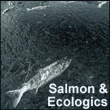forum
library
tutorial
contact

Chinook Runs are Big this Season
by Linda AshtonSeattle Times, July 31, 2003
|
the film forum library tutorial contact |

|
Chinook Runs are Big this Seasonby Linda AshtonSeattle Times, July 31, 2003 |
YAKIMA -- The once-legendary run of summer chinook on the 1,200-mile-long Columbia River is, for the second season in a row, reaching some of the highest numbers recorded in 40 years.
"We've seen in the last couple of years a 15-fold increase in passage on the summer chinook," Heather Bartlett, a multiregional fish program manager for the state Department of Fish and Wildlife, said this week.
Good -- but notoriously cyclical -- ocean conditions are primarily responsible, she said.
Last year set a modern-day record, with more than 127,000 adult summer chinook counted at the Bonneville Dam; more than 105,000 passing the John Day Dam; over 96,000 counted at the Priest Rapids Dam; and almost 63,000 reaching the Wells Dam.
Migration of summer chinook is still under way, but the numbers suggest a good return this year as well, with more than 112,000 adult summer chinook at Bonneville Dam; 91,000 at John Day Dam; more than 72,000 at Priest Rapids Dam; and almost 26,000 at Wells Dam.
"This has been an extraordinary fishery for the tribes," said Charles Hudson, spokesman for the Columbia River Inter-tribal Fish Commission in Portland.
For the first time since Lyndon Johnson was president, Columbia River tribes had a commercial gillnet fishing season on summer chinook. The tribal fishermen, working 140 miles between Bonneville and McNary dams, hauled in just over 4,400 fish from a run now estimated to total 117,000 when concluded.
The last time the tribes had a commercial season on summer chinook was in 1965, Hudson said. The fish historically were known as "June hogs," often topping 75 pounds or more.
Certain Indian tribes are guaranteed a portion of the runs by treaty.
"Ocean conditions have played the biggest role in the productivity of these stocks," Bartlett said. "We had some very poor ocean conditions in the late '80s and into the '90s that have changed."
One of the worst years for fish in recent memory was 1995, when just over 15,000 adult summer chinook made it to Bonneville Dam and fewer than 2,800 went as far upriver as the Wells Dam.
Summer chinook originate in the upper Columbia River and the Snake River.
More than half of this year's returning fish were reared in hatcheries.
"The thousands we're seeing right now are doing very good," Bartlett said. "Still, they could be doing better."
Good ocean conditions for fish typically are cyclic, and this year, favorable currents and cooler temperatures meant more fish food for the chinook, which leave freshwater for the Pacific as youngsters before returning to the rivers to spawn.
"If we had to rank who deserves credit, the ocean should get most of the credit," Hudson said.
And he added: "1999 and 2000 were very good water years -- good snowpack and good runoff. That gave those juveniles a good push out to the ocean."
Now is an opportune time for monitoring and evaluating the salmon runs, Hudson said, to better determine what management practices are working.
"We do need to take a good look at which of these fish survived, exactly how and where they're returning to," he said.
Studies that filter out the ocean conditions could help gauge what human actions are effective in fish recovery, he said.
If freshwater conditions are poor for migrating fish at the same time ocean conditions are also poor, stocks can diminish dramatically.
Freshwater habitat is "what we can change or improve or ensure is in good working order," Bartlett said.
learn more on topics covered in the film
see the video
read the script
learn the songs
discussion forum
